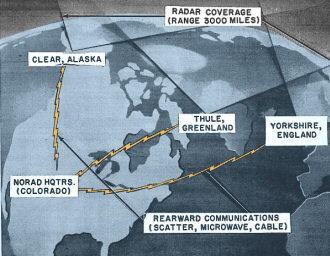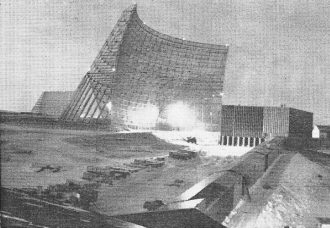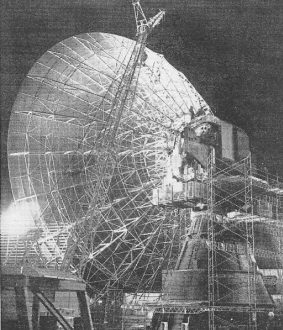Ballistic Missile Early Warning System - BMEWS
|
|
The Cold War is generally agreed to have begun between the U.S. and the U.S.S.R. on March 12, 1947, less than two years after the end of World War II, precipitated by Winston Churchill's famous "Iron Curtain" speech on March 5th and introduction of the Truman Doctrine on March 12th, thereby enraging Stalin. It was thus considered "cold" because while no armed conflict ("hot" action) occurred directly between the two countries, third party countries fought with each other at the behest of USSR and the U.S. using weapons and finances provided by the aforementioned countries. The Cold War officially ended on December 26, 1991, following the dissolution of the Soviet Union. In the interim, threats of nuclear war haunted the Earth's inhabitants. Once missiles were developed capable of delivering nuclear warheads between Russia and America - in both directions - it became necessary to build a network of over-the-horizon radars that could detect the flights of such projectiles and provide advanced notice of incoming atomic disaster. Fortunately (or unfortunately), a philosophy of Mutually Assured Destruction (MAD) ultimately prevented such an unfathomable scenario from ever taking place. The Ballistic Missile Early Warning System (BMEWS), reported here in a 1960 issue of Electronics World magazine, was the first in a long series of early warning systems. It went online on 1961. Ballistic Missile Early Warning System - BMEWS Powerful radars at these three sites will scan the skies over the polar region and Eurasian land mass. The Thule base is just about ready for full operation; the Alaska base is well along in construction; the Yorkshire base is just being started. America's primary early warning system for attacks by enemy missiles approaching over Northern Hemisphere is taking shape. The most powerful radars in the world, the gigantic detection radars of the U.S. Air Force Ballistic Missile Early Warning System, are now sending their beams out over the polar wastes as part of an exhaustive test program to ready the first of the BMEWS sites at Thule, Greenland for operation this fall. The radars have been designed to have a range up to 3000 nautical miles toward Eurasian skies to detect ballistic missiles aimed at the United States, Great Britain, and southern Canada. Warning of an attack by enemy ICBM's will be flashed to North American Air Defense Command (NORAD) Headquarters in Colorado Springs and to Strategic Air Command (SAC) Headquarters at Omaha. The entire system will provide approximately a 15-minute warning in case of missile attack. One of the four huge radar antennas that has been in-stalled at the Thule site. Each of these giant reflectors is 400 feet long and 165 feet high. Two separate feed systems for each reflector produce two fan-shaped radar beams at different elevations. Radar range is up to 3000 nautical miles. The radar tracking antenna to be installed at Yorkshire, England, is shown here during final construction. Reflector is 84 feet in diameter and it will be installed in 140-foot radome. The four huge fixed-surveillance radar antennas already installed at Thule, Greenland and to be installed at Clear, Alaska radiate narrow fans of powerful r.f. energy at two different elevations. When a missile passes through the lower fan, radar pulses will bounce off it and be detected by super-sensitive receivers. From these radar echoes, the position and velocity of the missile will be determined. Seconds later, as the missile passes through the upper fan, radar echoes again will be picked up, and position and velocity will be measured. The missile's trajectory can then be calculated from these coordinates since it will be in "free flight" (unpowered) as it passes through the fans. Calculation of the trajectory will permit prediction of the impact area, impact time, and point of launch. Data processing equipment will rapidly compute this data and flash a warning to NORAD Headquarters in the U.S. So powerful will the multi-megawatt radar beams be that personnel must travel between buildings in the active missile-detecting area through shielded passageways. These are large enough to permit truck passage. BMEWS Arctic bases will be thriving "small cities" complete with comfortable living quarters, good meals, medical facilities, and a variety of recreational outlets. The Thule site will house about 1000 men, while the Clear site will house about 600 men. Prime contractor for the over-all system design is RCA. Western Electric is supplying the rearward communications. The giant radars at Thule were designed by General Electric. The complete installation and maintenance for at least two years will be handled by the RCA Service Company.
Posted December 29, 2022 |
|



